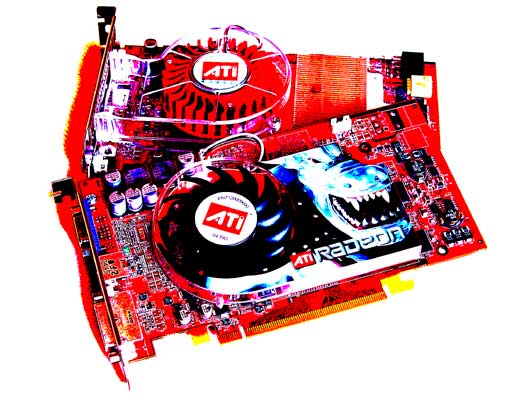Page 2
Now before we begin to explain technical details you already noticed that we have a PE 'Platinum Edition' of the card right? You need to be aware of that when (if) you decide to buy this card there is a regular x850 XT also. The difference is well of course, performance. The regular XT version has a 520 MHz core and 540 MHz memory frequency where the XT PE model has an increased 540c/590m MHz frequency. Other then that the price of course will differ. The plain XT version will cost you $499 where the XT PE version will cost $549. Yes your significant other will not be happy.
*cough*
| Type | Radeon X700 Pro | Radeon X700 XT | Radeon X800 Pro | Radeon X800 XL | Radeon X800 XT | Radeon X800 XT | Radeon X800 XT Platinum Edition | Radeon X850 XT | Radeon X850 XT Platinum Edition |
| codename | RV410 | RV410 | R420 | R430 | R420 | R423 | R423 | R480 | R480 |
| Interface | PCI-Express x16 | PCI-Express x16 | AGP | PCI-Express x16 | AGP | PCI-Express x16 | AGP/PCI-Express x16 | PCI-Express x16 | PCI-Express x16 |
Okay that being said let's talk business.
If you already own a Radeon X800 XT you might be wondering, what is the big difference between the two? ATi is being rather mysterious about that. They say that the R480 (Radeon x850XT) is based on the older R423 (Radeon 800 XT). Fact is that nobody outside ATI's camp really knows what exactly has been optimized. We do see a slightly higher core and memory frequency though. Benchmarks will also show that performance did increase, but not heaps. So why did they introduce this new 850 series then? Well, it is a little faster (then the last flagship card) but I'm betting that it had to do with product yields. Let's face it, the x800 series were and still are qvery hard to get. So if you ask me, I'd say (but it's just a guess) that the R423 chip has been revised for better yields, thus the 0.13nm based R480 will lead to a higher (better) production.

3D Feature wise these new parts do not differ from the x800, except from what we heard some Power Management features and Thermal Throttling capabilities. Nothing significant though.
The BoardSo then, when you first look at that huge x850 graphics card you'll likely get a flashback. Yes it looks like NVIDIA's FlowFX that we saw and mocked on the GeForce 5800 Ultra two years ago. So when I installed the card and powered up that rig for the first time my heart skipped a beat. It was making sound like a vacuum cleaner. But it lasted only for a couple of seconds after which the high pitch sound was gone. Even in-game you will not be bothered by the sound. Admittedly I must add that the cooling solution is not silent at all during gameplay. It is rather loud, I've checked/discussed this with a colleague journalist who measured the dBa level and it is at 50 dBa. It's not at all terrible though, it however is clearly there. It's no problem when you are in 2D / desktop mode though, actually then rotation speed is low and very silent. All the x850 XT's will have this form of cooling where the x850 Pro will be a single slot design.

Temperature wise the cooling design really proves it works. At idle, normal operation expect ~42 Degrees C. At 100% VPU utilization we measured a 60 Degrees C temperature, which is quite good actually.
When we look a bit further we notice Samsung memory, obviously GDDR3 memory and is rated 1.6ns - 1000:1.6 = 625 MHz, which is the nominal speed frequency the memory can take. It should be able to go a little higher as there often a 10% safety margin. At its default 587 MHz frequency it thus offers quite a bit of framebuffer bandwidth.
The last thing that we notice on this reference model is the fact that the card has two DVI Output connectors where in the past it had one DVI and one CRT/VGA connector. In the middle we see the traditional Video output connector, in this case as the card has been equipped with the Rage Theater chip and thus has an optional Video input through that same connector also.

Idle Graphics core temperature monitoring in Degrees C ~ 42

100% Stressed Graphics core temperature monitoring in Degrees C ~ 63
